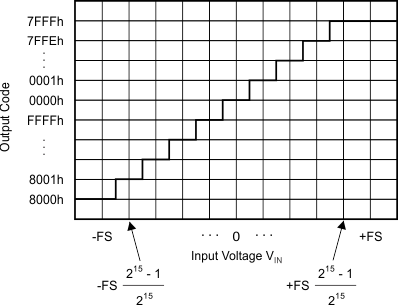SBAS925A August 2018 – November 2018 ADS1119
PRODUCTION DATA.
- 1 Features
- 2 Applications
- 3 Description
- 4 Revision History
- 5 Pin Configuration and Functions
- 6 Specifications
- 7 Parameter Measurement Information
- 8 Detailed Description
- 9 Application and Implementation
- 10Power Supply Recommendations
- 11Layout
- 12Device and Documentation Support
- 13Mechanical, Packaging, and Orderable Information
Package Options
Mechanical Data (Package|Pins)
Thermal pad, mechanical data (Package|Pins)
- RTE|16
Orderable Information
8.5.2 Data Format
The device provides 16 bits of data in binary two's complement format. Use Equation 5 to calculate the size of one code (LSB).
A positive full-scale input [VIN ≥ (+FS – 1 LSB) = (VREF / Gain – 1 LSB)] produces an output code of 7FFFh and a negative full-scale input (VIN ≤ –FS = –VREF / Gain) produces an output code of 8000h. The output clips at these codes for signals that exceed full-scale.
Table 6 summarizes the ideal output codes for different input signals.
Table 6. Ideal Output Code versus Input Signal
| INPUT SIGNAL,
VIN = VAINP – VAINN |
IDEAL OUTPUT CODE(1) |
|---|---|
| ≥ FS (215 – 1) / 215 | 7FFFh |
| FS / 215 | 0001h |
| 0 | 0000h |
| –FS / 215 | FFFFh |
| ≤ –FS | 8000h |
Figure 35 shows the mapping of the analog input signal to the output codes.
 Figure 35. Code Transition Diagram
Figure 35. Code Transition Diagram NOTE
Single-ended signal measurements, where VAINN = 0 V and VAINP = 0 V to +FS, only use the positive code range from 0000h to 7FFFh. However, because of device offset, the ADS1119 can still output negative codes when VAINP is close to 0 V.